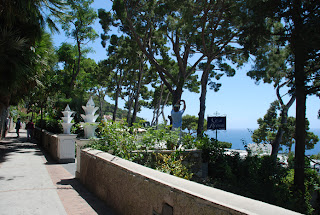 And they are absolutely right.
And they are absolutely right.Roma has more tourist than Napoli, that’s for sure. They are everywhere on the streets of the Roma. You would think that if you have seen one old building you have seen them all. Are they just here to soak up the scorching sun? Are they really history buffs absorbing 2000 years of ancient history as the tourist guides with their state-of-the-art broadcasting technology rattles off facts and fiction with such conviction and dedication? I see many travellers with thick travel guides but I am content just reading the signboards on site. I have learnt from experience that I don’t have the capacity to process the deluge of information – I don’t bother to remember anything except one or two key points.
Yes, I am impressed with Roma, especially its rich history, after visiting the Colloseo (the rest of the World refers to it as the Coliseum) and the San Pietro (where the tombs of the Popes are located) and the Fontana di Trevi. I decided on the hop-on-hop-off bus (cost 16 euro) as I was burnt out from all the walking in Napoli. It got me around but I was right, the service is overrated. If I had the energy I would have preferred the local public transport.



Can you believe I had halal roast chicken for brunch on my first day in Roma? There seems to be a big demand for halal food here where I am staying right next to the Roma Termini (Rome Train and Bus Terminal). I found this place through the Internet. Very cheap, 41 euro per night but they give a discount of 5 euro if you pay in cash. I looked at the receipt but it does not state the dates when I am staying. I asked politely to have it written but even after trying to oblige me, I still didn’t get what I want. I am leaving only tomorrow morning but I had to pay the lady before she leaves her station at 9 pm. Weird. Yesterday, I asked for the remote for the air-con and was told that the air-con is central. I told her it was not on in my room but she looked at her monitor and said it is on. So, I opened the window to let the cool breeze in. Today, the aircon decided to come alive. On the website, the hotel claims to provide Internet service but when I asked, I was told that because of new regulations by the government on controlling access to the Internet (after the terrorist attack), the hotel could not afford to provide the service. But hey, no loss, there many Internet Points (shops) all around (some better than others). So, don’t believe everything you read on the web. Having said that, I think what they are doing to these old solid buildings is wonderful. In this building alone there are 4 or 5 small hotels, each taking certain floors on certains wings (30 or 40 rooms each hotel). The rooms are tiny but clean and newly renovated. The staff? Some are both friendly and distance. They are weird. They say thank you but don’t go out of their way to be friendly. Who cares? I am out of here tomorrow.

Finally, food. I have been having pasta, pasta and pasta for one week. So, last night I gave in to my urge to have Chinese food. I had Beef Noodle Soup, Roast Duck and Jasmine Tea. That cost me 19.50 euro. But I love the noodles so I went back again for dinner tonight. The people are very friendly and attentive and since I speak a sprinkling of Mandarin, that seemed to get some attention. If you are ever at the Roma Termini and crave for Chinese food, the restaurant is just directly opposite the terminal on Gioberti.




















